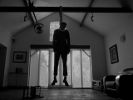Eye For Film >> Movies >> The Somnambulists (2011) Film Review
In 2008, Edinburgh artist Joanna Kane had an exhibition, entitled The Somnambulists, at the Scottish National Portrait Gallery. Comprising new photographs of facial masks cast 150-200 years ago by the Edinburgh Phrenological Society, this collection gave a haunting sort life to the images of people who had in fact died before they could ever be photographed.
Inspired by this exhibition, and horrified by his - and a nation's - apathy towards the recent invasion and occupation of Iraq, filmmaker (16 Years Of Alcohol, A Woman In Winter) and former Skids frontman Richard Jobson has created his own cinematic response, bringing a ghostly on-screen voice and presence to Basra's fallen. As a tribute to Kane, the film is also called The Somnambulists – except now that title is made not only to refer to his subjects' status as the living dead, but also to characterise the sleepwalking of a whole country into pointless, damaging war, with devastating consequences abroad and at home.

The Somnambulists opens with a striking image that immediately burns its way onto the viewer's retina. A figure in flames runs across an otherwise blacked out screen. It is an image that forces upon us two central aspects of this unusual film: first, its incendiary approach to sensitive topics that are often kept out of the mainstream press; and second, its presentation of harsh realities in a disarmingly stylised, even fictionalised manner. That burning man is clearly a concoction, realised through CGI – yet he is also an icon for the horrific fates of so many in the blistering heat, smoke and chaos of occupied Iraq, where violent death, as quantified in the memorial lists and statistics that close the film, was an undeniable reality for all sides of the conflict.
In what follows, there are 15 intense to-camera testimonies from British men and women who served in the deathtrap of Basra – 'talking heads' not just because they provide a running, searing commentary on real events from our recent history, but also because they have been filmed in black clothes against a black background so that their heads are all that is visible.
Their tone ranges from angry, embittered, accusatory, to calm, even reflective. One soldier found himself and his true calling out there, another became a hateful bigot, another a drug addict, another a suicide – and all were witness to horror, fear and death. Yet despite appearances, this is no documentary in the traditional sense. The speakers are all actors, performing other peoples' words that are at least in part fabrications, although drawn from Jobson's research and interviews. After all, the dead can tell no tales.
If, in these 15 dark sections, the 'interviewees' are confrontingly present, it is rather their absence that is highlighted in contrasting interstitial scenes. Presented in real British locations instead of a minimalist studio, these elegiac interludes feature the soldiers' loved ones and domestic haunts, all shot in black and white, with striking colour reserved only for the photographs of the departed visible in the background, remaining vivid as memories and images.
This is, of course, a reflection of the film's own purpose – to serve as an in-your- face memorial to those, from all sides, who have lost their lives in Basra, and as a j'accuse to all of us for letting them die. No matter that the film is schematic to the point of repetitiveness, and that its fictive frame risks undermining its testimonial credibility - The Somnambulists is a powerful, unapologetically political contribution to the discourse about this country's questionable manoeuvrings abroad since 9/11, lest we forget.
Reviewed on: 17 Oct 2011

















